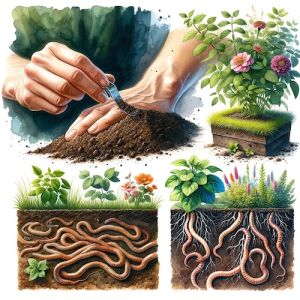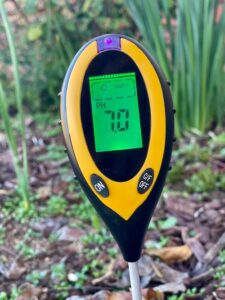Easy, low cost way to test your soil
As a gardener, the health and prosperity of your garden is all about the soil (for the most part). If you have poor soil, soil that doesn’t drain, high or low pH, or your missing nutrients or bio activity, your plants will not reach their true potential and you could be looking at wasting your time in money.
These four simple and basic garden soil assessments will help you understand the characteristics of your soil, and is crucial for proper garden care. Learning about your soil’s texture, structure, drainage, acidity, and nutrient content helps avoid issues that could hamper growth, and possibly harm your garden and the plants that live within. Here are the basics.
The Soil Ribbon Test
Soil texture plays a pivotal role in the health and success of any garden. It refers to the proportions of sand, silt, and clay present in the soil, each component contributing unique characteristics that significantly affect the soil’s ability to support plant life. The texture determines how well the soil can retain water and nutrients, as well as its drainage capability and aeration – all vital factors for robust plant growth. Well-textured soil ensures that roots have an ideal balance of moisture, air, and nutrients, creating an environment conducive to healthy plant development. Understanding and managing soil texture is therefore crucial for any gardener aiming to cultivate a thriving, vibrant garden.
As mentioned, soil composition is generally classified into clay, sandy, or loamy. Clay soil is nutrient-rich but drains slowly, sandy soil drains quickly but retains little moisture and nutrients, and loamy soil is considered ideal, maintaining a good moisture and nutrient balance.
To identify your soil type, take a moist handful of soil (add water if needed), squeeze it between your thumb and forefinger, and then observe. If it holds its shape but crumbles when poked, it’s loamy soil. If it retains its shape without crumbling, it’s clay. If it falls apart immediately, it’s sandy soil. Knowing this helps in improving your soil. More here: Soil Ribbon Test for Gardens
Percolation. (Perc)/Drainage Test
Good drainage is crucial for plant health primarily because it prevents waterlogging. When there’s too much water in the soil, it can create a waterlogged condition where plant roots are deprived of oxygen. Most plants require a certain amount of air, especially around their roots, for optimal growth and health. Adequate drainage ensures that roots are not submerged in water for extended periods, which is vital because over-saturated roots can lead to root rot and other diseases. This condition can ultimately suffocate and kill the plants. Additionally, well-drained soil helps maintain the right balance of moisture and air, encouraging healthy root growth and nutrient uptake, which are essential for the overall vitality of the plant. The back of the book – Good drainage is essential for plant health. To test this:
- Dig a six-inch-wide, one-foot-deep hole.
- Fill it with water, let it drain, then refill.
- Time how long the second water filling takes to drain. More than four hours to drain indicates poor drainage.
Earthworm Test for Soil Health
The presence of earthworms in your garden soil is a strong indicator of its health and fertility. The earthworm test is a simple yet effective way to assess the biological activity and overall quality of your soil. Here’s how it works and what the results mean.
How to Conduct the Earthworm Test
- Timing and Conditions Ensure the soil temperature is at least 55 degrees Fahrenheit and is moderately moist. These conditions are ideal for earthworm activity.
- Digging the Soil Carefully dig a hole about one foot deep and one foot across. It’s best to do this gently to minimize harm to any earthworms present.
- Counting Earthworms As you remove the soil, sift through it and count the number of earthworms you find. After counting, replace the soil in the hole.
Interpreting the Results
Now that we have our worm count, we can apply that to general standards and understand the health of our soil.
- High Earthworm Count– If you find 10 or more earthworms in the soil sample, it’s a strong indication of healthy, fertile soil. Earthworms are beneficial for the soil as they aerate it while moving through, improve its drainage, and enhance nutrient availability by breaking down organic matter.
- Low Earthworm Count– Fewer than 10 earthworms might suggest that your soil lacks sufficient organic matter or has issues with acidity or alkalinity. It could also indicate compacted or poorly aerated soil, which is not conducive to earthworm activity.
Master Gardener Tip: Earthworms, commonly found in gardens and soil, are soil-dwellers that burrow deeply and help aerate and mix the soil layers, thus enhancing soil structure and nutrient distribution. On the other hand, vermi-composting worms, like red wigglers, are surface-dwellers and thrive in decomposing organic matter rather than soil. They are used in vermi-composting systems to break down kitchen scraps and organic waste into nutrient-rich compost, known as worm castings. Unlike earthworms, vermi-composting worms prefer a controlled environment and are ideal for indoor or small-scale composting.
How do earthworms help the soil?
Earthworms are often called ‘nature’s tillers’. Their movement through the soil creates channels that improve aeration and water infiltration. They feed on organic matter, breaking it down into more accessible forms for plants, thereby enriching the soil. Their castings (excretions) are also rich in nutrients, acting as a natural fertilizer. A thriving earthworm population is a good sign of organic matter richness and a balanced soil ecosystem, which is fundamental for healthy plant growth.
The earthworm test provides a straightforward way to gauge the biological health of your soil. A garden with a healthy earthworm population is likely to have well-aerated, nutrient-rich soil, which is a key component in supporting vigorous plant growth and a successful garden.
Soil pH Level Test
Soil pH is a critical factor in determining the health of a garden. It affects the availability of nutrients to plants and the soil’s microbial activity. The pH scale measures soil acidity or alkalinity, ranging from 0 (very acidic) to 14 (very alkaline). Managing soil pH through regular testing is essential for a thriving garden.
Understanding Soil pH
Acidic soil, with a pH below 7, makes certain nutrients like iron, manganese, and phosphorus more available. However, it may lack others such as calcium and magnesium. While some plants prefer acidic conditions, extremely low pH levels can limit plant growth and nutrient absorption. Neutral soil, around a pH of 7, is often ideal for most plants, providing optimal nutrient availability and supporting a diverse range of soil microbes. Alkaline soil, with a pH above 7, can lead to deficiencies in nutrients like iron, zinc, and manganese and may also impact soil structure and fertilizer effectiveness.
Conducting a Soil pH Test
A soil pH test is a straightforward process that can be done using home testing kits, by sending soil samples to a laboratory or through the use of a soil meter. These tests provide valuable information on the soil’s current pH level. Once the pH level is known, appropriate measures can be taken to adjust it. For acidic soils, liming materials like limestone can be added to raise the pH. For alkaline soils, incorporating organic matter such as compost, or using sulfur or aluminum sulfate can help lower the pH.
Implications of Soil pH on Garden Health
The pH level of soil directly influences plant health and productivity. Certain plants have specific pH requirements, and growing them in soil with an incompatible pH can lead to poor growth and yield. Additionally, the pH affects soil bacteria and fungi, essential for decomposing organic matter and nutrient cycling. Therefore, maintaining the right pH balance is key to ensuring that plants receive the necessary nutrients and thrive in their environment.
Understanding and managing soil pH is fundamental to garden health. Regular testing and adjustments as needed can lead to a more productive and vibrant garden, ensuring plants have the right conditions for optimal growth.
In Conclusion – Soil is Life
In conclusion, the health and productivity of a garden are deeply influenced by various soil characteristics, with soil texture, pH, and biological activity playing pivotal roles. Understanding the composition and condition of your soil through tests like the compression test, earthworm count, and pH analysis is key to creating an optimal growing environment. Adjusting and maintaining these soil properties can significantly impact plant growth and garden vitality. Whether it’s enhancing drainage, balancing pH levels, or enriching the soil with organic matter to support a thriving ecosystem, these efforts culminate in a robust and flourishing garden. Gardening, therefore, is as much about nurturing the soil as it is about caring for the plants themselves. Happy Gardening!!
Recent Posts

The Advantages of Built-Up Garden Beds: A Gardener’s Best Friend

The Secret Weapon for Lush Blooms: How to Create the Perfect Fertilizer Schedule

Create a Stunning Cottage Garden with These Easy-to-Grow Flowers

Fastest Growing Trees: Transform Your Landscape Quickly

What to Plant in July: A Comprehensive Guide for Gardeners












You must be logged in to post a comment.